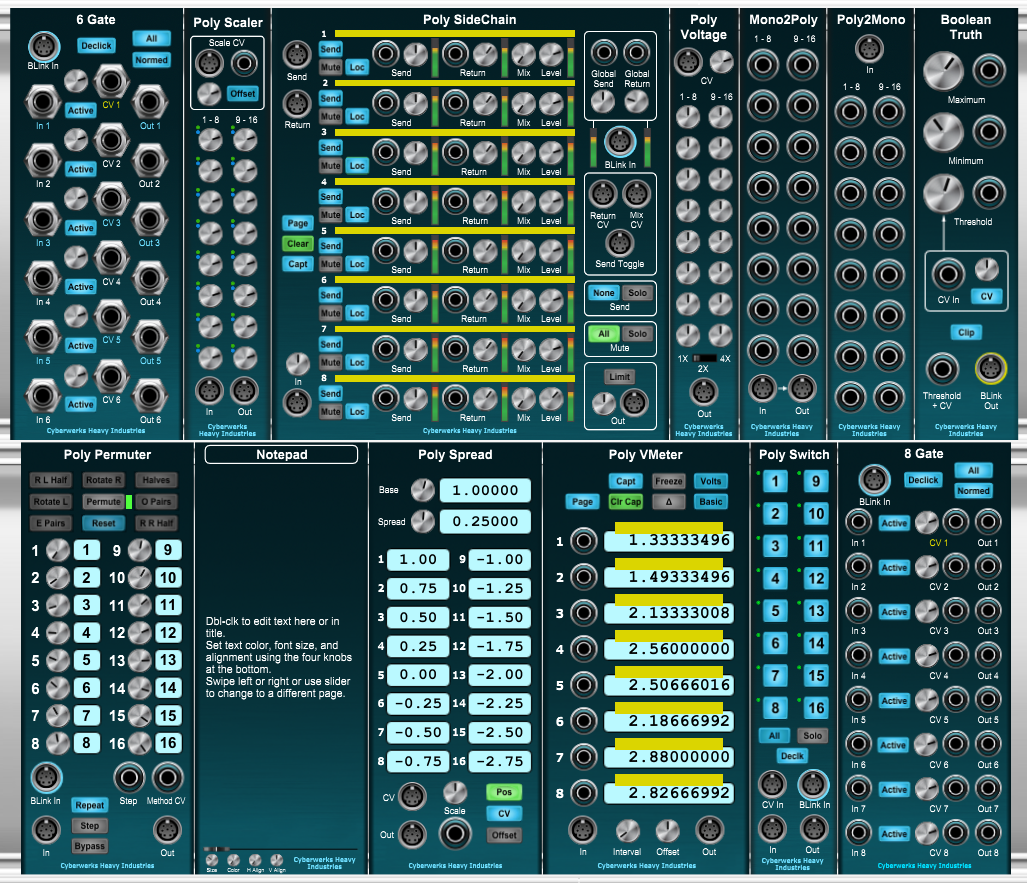Or Get It As Part of The First Baker's Dozen and Save $25
Manufacturer: Cyberwerks Heavy Industries
$5.00 $10.00
Or Get It As Part of The First Baker's Dozen and Save $25
Poly Permuter
Poly Permuter maps the sixteen channels of a polyphonic input to a polyphonic output on a manual or programmed stochastic basis. In its most basic form this functionality is displayed by the sixteen numbered knobs and display fields that make up the center section of the module; for each numbered channel, the knob determines the channel the input will be mapped to, as shown by the associated display field. This is the simplest way of changing the mapping, but not necessarily the most interesting, although it is the only way to achieve mappings that aren't bijections (i.e., one-to-one and onto).
The nine buttons in the array at the top of the module each change the mapping in a specified fashion when pressed. They function as follows, in the order they occur in the array:
-
R L Half (Rotate Left Half) rotates the destinations of the lower-numbered half of the channels. For instance, if the number of Poly Voices is set at, say, twelve, then the channels numbered one through six will be rotated.
-
Rotate R (Rotate Right) rotates all channels one position to the right, with the highest rotating around to the lowest position.
-
Halves (Swap left and right halves) swaps the lowest half of the channels with the highest half.
-
Rotate L (Rotate Left) functions identically to Rotate R, save that it rotates in the opposite direction.
-
Permute performs a random permutation of all active channels.
-
O Pairs (Swap Odd Pairs) swaps odd-numbered pairs starting from the outside pairs and working inward.
-
E Pairs (Swap Even Pairs) works like O Pairs, but on even-numbered pairs.
-
Reset returns the mapping to the identity mapping (i.e., one to one, two to two, etc.).
-
R R Half (Rotate Right Half) performs like R L Half, save that it operates on the right (higher-numbered) half of the channels.
Pressing any of these buttons will also update the channel knobs and displays. Pressing more than one of these buttons sequentially has the effect of performing functional composition on the elements of a non-Abelian permutation group.
Things get a bit more interesting if we press the Step button instead of one of the top buttons. This button could have been reasonably named "Stagger," as it causes the module to perform a single step of a Drunkard's Walk over the array of nine buttons, considering the array as wrapping from side-to-side, top-to-bottom, and corner-to-corner (topologically, a homeomorphism of a discrete plane to a sphere). The last executed button is left lit, so you can track the Drunkard's Walk, if you've any interest.
Since connectivity is the name of the game in a modular system, of course there are CV inputs. The Step input jack allows you to feed in anything that could be used as a gate signal, including, naturally, gate signals (triggers, however, won't work as you might expect, so convert them to gates before feeding them to the Step jack). The Step signal will trigger a "stagger" each time it rises above the system truth level of 2.5 Volts after having fallen below that level (or, if a BLink input is supplied to the module, above the - possibly modulated - truth level specified in that input).
The Method CV input allows you to specify a particular one of the nine buttons programmatically. The CV is clamped between zero and 4.5 Volts, then interpreted in half-Volt intervals to arrive at specific button numbers. All buttons other than the currently specified button are disabled, and a green light turned on adjacent to the selected button. In this state, only the selected button can be triggered or pressed, forcing the Drunkard's Walk (which can still be a true Walk, if the CV varies stochastically). Note that the clamping of the CV value can cause R L Half and R R Half to occur more frequently than statistically likely, so it's best to actually feed in values between zero and 4.5 Volts inclusive.
The Repeat button allows states to repeat in the Walk (i.e., the Drunk stays where he is). If this button isn't lit, repeats are not allowed.
The Bypass button temporarily sets the module to the identity mapping, although the Walk will go on in the background.
There are some natural limitations on the functioning of the module. For instance, while values are continually output at the current sample rate, most of the pseudo-random operations are performed every fiftieth of a second. Because of this, you can experience a form of aliasing (not of the signals, which the module never changes, but of the permutation operations), which can cause the module to appear to bog down, or function sporadically. Simply put, don't try to step it too fast; it's not designed for switching outputs at more than middlin' LFO rates, and certainly not at audio rates (you can send audio through the channels, but can't swap those channels around at audio rates).
Poly Permuter uses specially entangled mil-spec qubits made available to Cyberwerks by HAL's Mycroft Labs under the auspices of DARPA Grant No. [REDACTED].




















































































